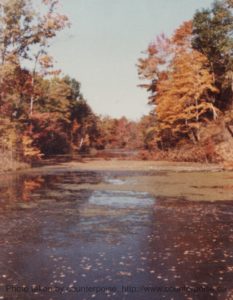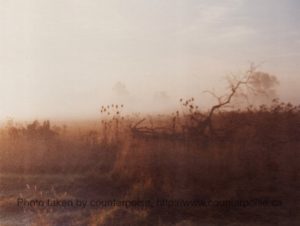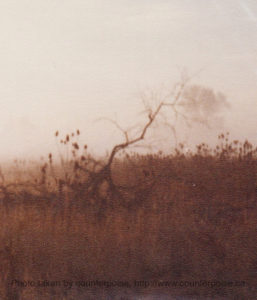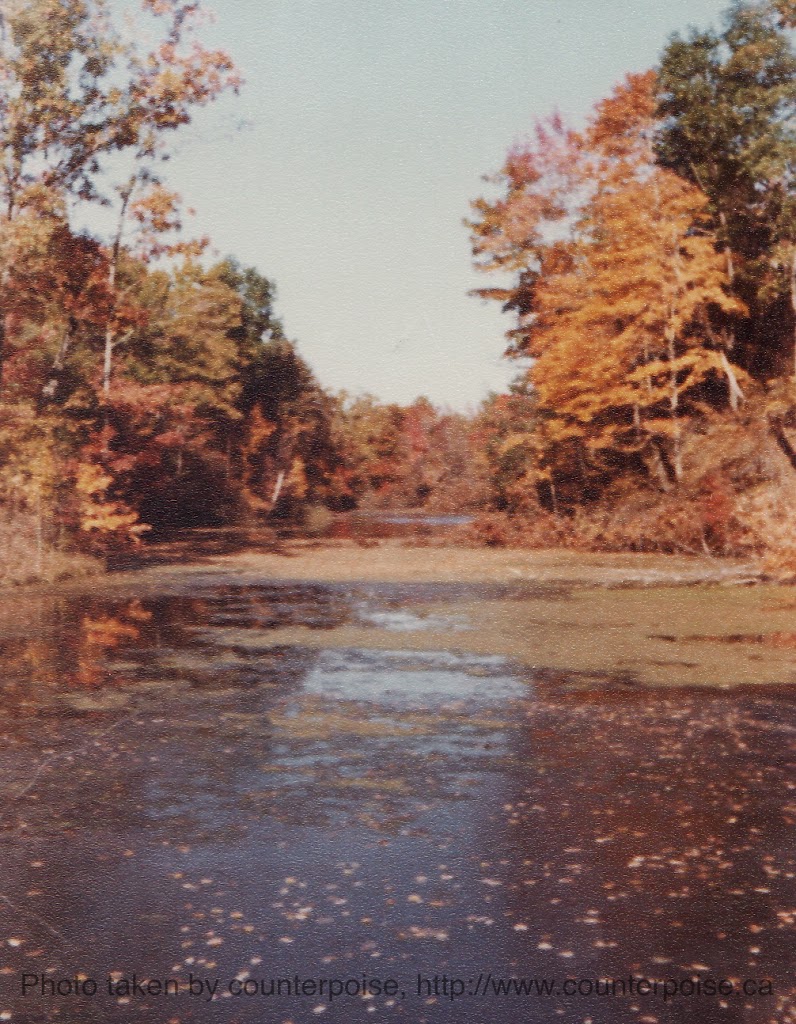Disclaimer: My references to the writings of other people–both aboriginal and non-aboriginal–do not in any way imply that they share my views on this matter. The opinions expressed here are my own and do not necessarily represent those of my family, friends or associates.
I readily admit I am far from an expert on the establishment of urban reserves. Have learned from my research that this is a very complicated topic, and I have no first-hand knowledge of the subject. Many of the approximately 120 urban reserves that currently exist throughout Canada are reportedly functioning very well, so this could end up being a good news story for all involved.
But I feel, as a citizen of London, Ontario, and as someone with two generations of experience with aboriginal issues, including with former and current residents of the Chippewas of the Thames First Nation (COTTFN), that I would like to add my point of view to the discussion.
A Reminder of Happier Times Regarding COTTFN
As I was working on this post, I became quite despondent, thinking about how things had not worked out as I had hoped regarding my relationship with some people from COTTFN and their associates. To cheer me up, I went through an old album and found some photos I took while visiting a resident of COTTFN during happier times. As I recall (and my 11 photos bear this out), she invited me for Thanksgiving dinner at her home in 1980. She also took me to the Longwoods Conservation Area and Ska-Nah-Doht Village, which are located not far from the reserve. I believe I took the photo below at the conservation area.
 |
| I probably took this at Longwoods, ca. 1980 |
Introduction
At the end of January 2013, it was announced in the London Free Press that the COTTFN (cottfn.com), which is about 20 km southwest of London, Ontario, Canada, was in preliminary talks with the City of London (CoL) about possibly establishing an urban reserve in the city. This development is the result of COTTFN settling a land claim that dates back to the 19th century.
History of the COTTFN Claim and Settlement
From 1818 to 1822, the COTTFN established both a reserve on the Thames and one at Big Bear Creek. The band never surrendered Big Bear Creek (located near Florence, Ontario), but the government sold it anyway in the 1830s. The last resident was forced to move to the Thames site about 100 years ago.
Colonel J.B. Clench, who was an Indian Affairs superintendent from 1830 to 1854, misappropriated funds that rightfully belonged to the COTTFN, as well as other bands. From 1847 to 1854, there was an investigation into this, called the Clench Defalcation Claim, but nothing ended up getting resolved. Lawyer A.J. Chisholm was hired by the COTTFN in 1906 to try and resolve the matter, but he negotiated a settlement that was less than the band thought was fair.
In 1974, lawyer and former COTTFN chief, Delbert Riley, guided the band through a legal challenge of the 1906 payment, but the government rejected it. An inquiry into the Clench Defalcation Claim commenced in 1997, which led to the reopening of negotiations in 1999.
Finally, in June 2005, a settlement was reached. Some of the financial compensation was earmarked for land claims research to pursue other claims that would involve compensation for lost land with land, instead of money.
In September 2012, the federal government offered COTTFN a chance to expand their land base by 60 per cent. But the matter had to be voted on by the reserve’s more than 2,600 residents, 941 of whom lived on reserve as of August 2012.
On March 23, 2013, the Chippewas voted 1,200 to 101 in favour of the settlement.
Details of the Settlement
I congratulate the COTTFN for having negotiated their claim to a final settlement, after many years of lobbying and persistence. It is precedent setting because:
• The band can potentially set up reserves in four places in Southwestern Ontario, other than their current location; these four additional locations do not have to all be in one place. The band can also expand the boundaries of their current reserve. The total amount of the increase is 2,017 hectares
• The band has an unlimited time frame for establishing these reserves
• This would be Ontario’s first urban reserve
Further details:
• The federal government is providing $120 million
• $30 million has been earmarked to purchase land. Plus the band has an additional $15 million from a pension fund that can be used towards this purpose. Economic development projects resulting from these investments could increase the band’s economic self-sufficiency
• One of the projects COTTFN is considering is an industrial park on the 400 series highways. They plan to use as their model the Chippewas of Sarnia Industrial Park, which started in 1991
• $30 million for seniors, $20 million for community members and $10 million for post-secondary bursaries
Controversial areas:
• Because the band can offer a lower tax rate, it could weaken London’s economic and industrial base
• Ray Deleary, COTTFN senior policy analyst, said that businesses would be offered 99-year leases, but larger outfits may prefer to own the property
• COTTFN has managed to keep the surrender provisions of the settlement open ended. Chief Joe Miskokomon said “some members of his community are not happy with surrendering their title to the land in exchange for money and political approvals. . .the band doesn’t believe it has surrendered rights to resources above and below the land” (London Free Press, March 26, 2013)
London Mayor, Joe Fontana, said he has held some preliminary talks with Miskokomon about the matter and is “excited” about the prospect. The city is waiting for COTTFN to complete a settlement and economic development plan before more detailed talks commence.
Points for Discussion
My concerns fall into the following categories: political, policing, governance interface, the effect of the urban reserve on aboriginals who are not from COTTFN, and the impasse I feel I have reached with some former and current COTTFN residents.
A. Possible Political Tensions
Michael E. Gertler, a sociology professor at the University of Saskatchewan, penned a chapter of Urban Indian Reserves (1999) entitled “Urban Indian Reserves and Community Development: Some Social Issues.” Gertler noted that the political nature of urban reserves could lead to changes in relationships and power structures. His observation is just as applicable today as it was at the time he wrote it.
A.1 The COTTFN’s Objections to Bill C-45
On October 18, 2012, the federal government introduced the omnibus budget Bill C-45 (Jobs and Growth Act, 2012), which contained provisions that many aboriginals and their supporters did not like (although some natives supported various aspects of the bill).
(Note: Opposition to this bill has commonly been referred to as the Idle No More (INM) movement. I prefer, nonetheless, to stay away from this term, since a number of the INM founders stated they did not condone the actions taken by some under this moniker.)
The COTTFN objected to Bill C-45 in an “urgent memo” it released November 28, 2012. The covering page of the memo was signed by Chief Joe Miskokomon, who said it was a “notice of support for Anishnaabeg, Lenni Lenape, Haudenosaunee and all Indigenous people in Anishnaabe territory of Southwestern Ontario to join in a united peaceful opposition to the legislative attacks by the federal conservative government.”
On December 19, 2012 and January 10, 2013, the COTTFN were involved with two peaceful Bill C-45 protests that blocked roadways in London. Then on January 28, 2013, the London Free Press reported that “native leaders” were employing other lobbying methods, including the use of social media, to try to prove to “Southwestern Ontarians” that “we are all treaty people.” Miskokomon is quoted in this article as saying “[o]ur objective is not to inconvenience people, but to educate them. . .” This is understandable, since many aboriginals who opposed the legislation feel strongly that it endangers not only their way of life, but also that of other Canadians, e.g., the reported erosion of environmental safeguards.
Although Bill C-45 received Royal Assent on December 14, 2012, and is now law, the opposition to it remains strong among many aboriginals and their supporters. This makes me wonder if future native leaders might have more radical ideas about how to settle the score with the government, and that Londoners could get caught in the middle. I hope there are provisions in the arrangements made between the COTTFN and the CoL to make this less likely to happen.
A.2 Contentious “Surrender” Provisions in Settlement
I can understand why the COTTFN membership would not be keen on the surrender provision, but I think there needs to be more clarification on their part as to what this objection entails. What exactly do they mean when they say they own the resources above and below the land? Does this only apply to the current reserve and the 2,017 hectares they can potentially obtain? Or are they also talking about the Big Bear Creek area?
A particularly worrisome aspect for me is a statement made by Ray Deleary in the “Big Bear Creek Specific Land Claim” video, that was published on youtube.com five days before the COTTFN ratified the settlement. Various stakeholders in the land claim were voicing their opinions as to what should be done if the membership rejected the settlement and wanted to get the Big Bear Creek area back. Deleary said an option would be to move in as was done at Caledonia or Ipperwash–or words to that effect–at least that’s my interpretation of what he said.
Regardless of the context in which Deleary said this, it is still troubling to me that he would voice such an option. The Caledonia and Ipperwash disputes have contributed to frayed relations between native and non-native neighbours in those areas. In both cases, millions of dollars were spent to deal with the fallout. Miskokomon said in the video that that sort of approach would not be pragmatic, but what if he is defeated as chief, and someone with more radical views takes over?
As mentioned already, there were 101 who voted against the settlement. Is there a possibility that some of these dissenters could be of the view that the Big Bear Creek area should still be taken back?
I realize the COTTFN have legitimate grievances, but I also think that, if they want to maintain positive relations with non-aboriginal business partners and the CoL, they need to recognize that Deleary’s statement could contribute to apprehension, even though he stated it in a hypothetical context.
As the “Big Bear Creek Specific Land Claim” video makes clear, COTTFN members have differing points of view in certain areas, which is, of course, the case in any community. But it worries me that these differences could spill over into actions that may create difficulties down the road. For instance, from December 21, 2012 to January 3, 2013, some members of the Chippewas of Sarnia reserve (Amijwnaang First Nation) blockaded the CN rail line over objections to the Bill C-45 legislation, even though the band council recommended alternative ways of raising objections. Are there going to be any stipulations built into agreements between the COTTFN and CoL to minimize these sorts of protests occurring?
B. Policing
I think the CoL needs to take the issue of policing very seriously because of the aboriginal protests that have occurred in Ontario from time to time since the 1970s.
The Ontario government has been one of the worst for employing appeasement methods to native issues. From the Ipperwash Inquiry recommendations to the occupation of the former Douglas Creek Estates in Caledonia, to the non-action or delayed action by the Ontario Provincial Police (OPP) regarding various protests that occurred during the December 2012-January 2013 period, provincial officials have frequently demonstrated that they prefer to avoid confrontation at all costs, despite the fact that many non-natives have been inconvenienced, hurt or even permanently injured as a result.
Consequently, I think the CoL should strike out on a different path in their negotiations with the COTTFN, one that stresses the safety of all people involved. Miskokomon and some other COTTFN spokespeople have indicated by their recent comments that they want to employ a pragmatic approach in their dealings with their non-native neighbours. I think this view needs to be translated into specifics in any urban reserve agreement.
C. Governance Interface
I contend it is extremely important that every possible detail be ironed out before the urban reserve is established, not only because it makes good business sense, but also because it leads to greater trust between the negotiating parties. One of the editors of the Urban Indian Reserves book, Joseph Garcea, mentioned the importance of trust in an interview he gave with the London Free Press, January 30, 2013.
Furthermore, court decisions handed down of late have stressed the need for clearly spelling out the rights and responsibilities of all negotiating parties in treaty settlements.
Moreover, Ryan C. Walker, who is in the Geography and Planning Department of the University of Saskatchewan, echoed this refrain in his 2008 article, entitled “Improving the Interface between Urban Municipalities and Aboriginal Communities.” He consulted with aboriginal and non-aboriginal stakeholders and resource people in seven cities before he prepared his article.
As Walker points out, Canadian treaties with aboriginals are between the federal government and the band, and governance for municipalities falls under provincial statutes. He thinks that both the federal and provincial governments could do more to improve the interface with urban centres. But he asserts that municipalities should be proactive about improving their affiliation with aboriginal communities, rather than waiting for action to be taken at the two higher levels.
One of the things I learned from my research is that municipalities cannot veto the creation of an urban reserve. This makes it all the more crucial for CoL to ensure the agreement they establish with COTTFN leaves no stone unturned.
D. What Do Urban Aboriginals Who Are Not from COTTFN Think?
As Gertler explains, urban reserves can create complications in terms of other types of urban self-government, and can also contribute to divisions among urban aboriginals. I think his comment needs to be taken into consideration by all negotiating parties.
When there was first discussion about the COTTFN establishing an urban reserve, Miskokomon mentioned that one of the options might be “central London.” The 2006 census listed 4,500 first nations living in London. How many of these are former and current COTTFN residents and how many are not? What do the ones who are not think about this?
Although the media focus has moved to the possible creation of an industrial park on the 400 series highways, the “central London” option could still resurface at a later date, since the band has an unlimited amount of time to establish additional reserves.
Miskokomon said that economic development projects initiated by COTTFN could create opportunities for not only his reserve, but also for other first nations. I do not doubt this for a minute, but it is also well known that aboriginals do not always speak with one voice. Quite a number of natives have publicly acknowledged this fact.
In 2011, the Environics Institute released the Urban Aboriginals People Study (UAPS). This study involved interviews with first nations, Inuit and Metis in 11 Canadian cities, including Toronto and Ottawa. It also encompassed interviews with non-aborginal urban residents. Although the UAPS (uaps.ca) did not include urban reserves, it does provide considerable insight, e.g., many natives consider the city home, and most feel confident that they can retain their culture in an urban setting. The study also found that most urban aboriginals did not think that any organization, including native, represented their interests very well.
My personal experience confirms these findings, and I have also found that London aboriginals have differing points of view. For instance, my play, Fishy Wisdom, which was produced at the London One Act Festival in 2004, dealt with controversial matters relating to aboriginal accountability. To make a long story short, there were some aboriginals who were supportive of my play and others who were not.
Furthermore, when I have asked some London aboriginals where they were from, they have occasionally said they were from London. In other words, they considered London their home, and not the reserve where their parents or grandparents originally came from. I have also surmised (although not recently) that aboriginals in this city come from many different tribes and reserves. So that is why I can understand why Gertler would recommend that this matter be dealt with.
I realize there are many bands that function well as collectives, which is one of the reasons why so many urban reserves are reportedly successful. Am just pointing out that a “one size fits all” approach does not necessarily address the needs of all aboriginals in the CoL.
E. Personal Impasse
From the mid-1970s until 2007, I had a fair bit of contact with some former and current COTTFN residents (except for when I worked in native organizations in Northern Ontario and the Northwest Territories during this period).
Some of my happier moments relating to COTTFN include:
• The Thanksgiving meal mentioned at the beginning of this post. As I recall, I took the photo below though the window of my host’s home
 |
| I took this at COTTFN, ca. 1980 |
• Going into the bush with a reserve resident, where we located and later ate nutritious wild plants
• Attending services at the reserve church, during which some of the residents would pray to the four directions
• Doing some consulting work for the band relating to genealogy and other matters
• Donating books and other items to the reserve resource centre
• One or two COTTFN residents attended my politically correct Amelia play at Eldon House (but not my politically incorrect Fishy Wisdom)
Here’s another photo I believe I took through my host’s window.
 |
| Another photo at COTTFN, ca. 1980 |
In 2007, I reached an impasse with some former and current COTTFN residents and their supporters. We disagreed on how this impasse could be rectified, and I stopped having any contact with them.
Before some of you start blasting me for being racist, let me assure you that I have also reached an impasse with a number of non-aboriginals, and have curtailed contact with them as well. I march to my own drummer, but some people, regardless of race, prefer that I conform to what they want me to be. I prefer to be myself.
I realize there are probably many non-aboriginals who continue to maintain positive relations with COTTFN, so I do not want to give the impression that what happened to me could happen to them.
Conclusion
I think the CoL should negotiate with the COTTFN with the mindset that both have something important to contribute to the discussions. And I also contend that they need to carefully study what has worked and what has not worked in terms of other urban reserves. I also think that CoL must be ever mindful of the political tensions between the federal government and the COTTFN, as well as the problems I feel have been caused by what I consider to be the Ontario government’s racial/political policing methodology. Finally, I recommend that the CoL conduct public consultations regarding this urban reserve issue, particularly if the decision is made to locate one of the reserves in “central London.”
Bibliography
Aboriginal Affairs and Northern Development Canada. “Backgrounder: Urban Reserves: A Quiet Success Story.” August 14, 2008. aadnc-aandc.gc.ca.
Barron, F. Laurie, and Joseph Garcea, ed. Urban Indian Reserves. Saskatoon: Purich, 1999.
Blatchford, Christie. “Judge slams Ontario police for not breaking up Idle No More protesters.” National Post, January 7, 2013. nationalpost.com
Burleton, Derek, and Sonya Gulati. “Debunking myths surrounding Canada’s aboriginal population.” TD Economics. June 18, 2012.
Cairns, Alan C. First Nations and the Canadian State. Kingston: Queen’s University, 2005.
Chippewa Thunderbird. “Big Bear Creek Specific Land Claim” (video). You Tube. March 19, 2013. youtube.com.
Chippewas of the Thames First Nation. “Urgent memo: Notice of Support for Grassroots Movement Against Legislative Attacks.” November 28, 2012. cottfn.com.
Curtis, Christopher. “‘We believe our future is at stake,’ Idle No More movement founder Tanya Kappo says.” National Post. December 21, 2012. nationalpost.com.
Curtis, Christopher. “Idle No More founders distance themselves from chiefs.” National Post. January 1, 2013. nationalpost.com.
DeBono, Norman. “Chippewas of the Thames First Nation may use its tax-free status to lure industry and undercut London’s industrial tax rate.” London Free Press. March 26, 2013. lfpress.com.
DeBono, Norman. “Dividing the industry pie.” London Free Press. April 7, 2013. lfpress.com.
Friesen, Joe. “Canada’s urban aboriginals feel politically unrepresented, poll finds.” Globe and Mail. April 6, 2010. globeandmail.com.
Huffmediatalk. “Big Bear Creek Specific Land Claim News Conference” (video). You Tube. March 26, 2013. youtube.com
Idle No More. “Face and Leaders of Idle No More is the Grassroots People.” December 31, 2012. idlenomore1.blogspot.ca.
Jeffrey, Tara. “Band council does not support blockade.” Sarnia Observer. December 31, 2012. lfpress.com.
King, Hayden. “We natives are deeply divided. There’s nothing wrong with that.” Globe and Mail. January 9, 2013. globeandmail.com.
LEGISinfo. “C-45.” December 14, 2012. parl.gc.ca/LegisInfo/BillDetails,aspx.
O’Brien, Jennifer. “A political scientist who has studied urban reserves says negotiations start with trust.” London Free Press. January 30, 2013. lfpress.com.
O’Brien, Jennifer. “Native group turns to social media to engage all ‘treaty people.'” London Free Press. January 28, 2013. lfpress.com.
O’Brien, Jennifer. “Native reserve eyed for London.” London Free Press, January 30, 2013. lfpress.com.
Oved, Marco Chown. “Thames First Nation to buy land in London for Ontario’s first urban reserve.” The Star. February 15, 2013. thestar.com.
Richmond, Randy. “Chippewas of the Thames First Nation approves land claim deal.” London Free Press. March 26, 2013. lfpress.com.
Saskatoon, City of. “City of Saskatoon Urban Reserves Frequently Asked Questions.” ca. 2012. saskatoon.ca.
Sher, Jonathan. “Chippewas of Thames to expand.” London Free Press. September 26, 2012. lfpress.com.
Switzer, Maurice. “First urban reserve in London.” Anishnawbek News. March 24, 2013. anishnawbeknews.ca.
Walker, Ryan C. “Improving the Interface between Urban Municipalities and Aboriginal Communities.” Canadian Journal of Urban Research 17, no 1 (2008).
Young, George. “Ontario First Nation settles 171-year old claim.” Windspeaker. 2005. ammsa.com.
